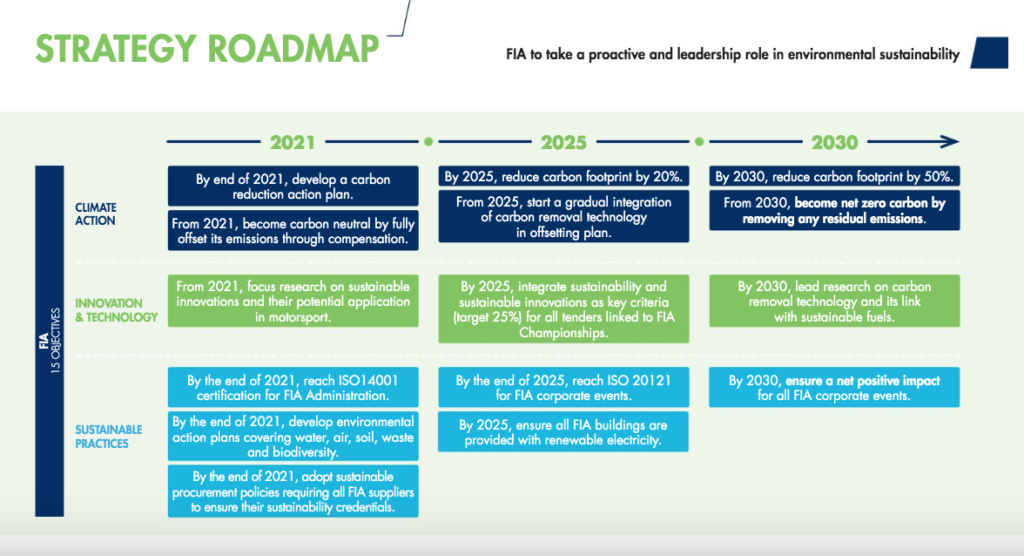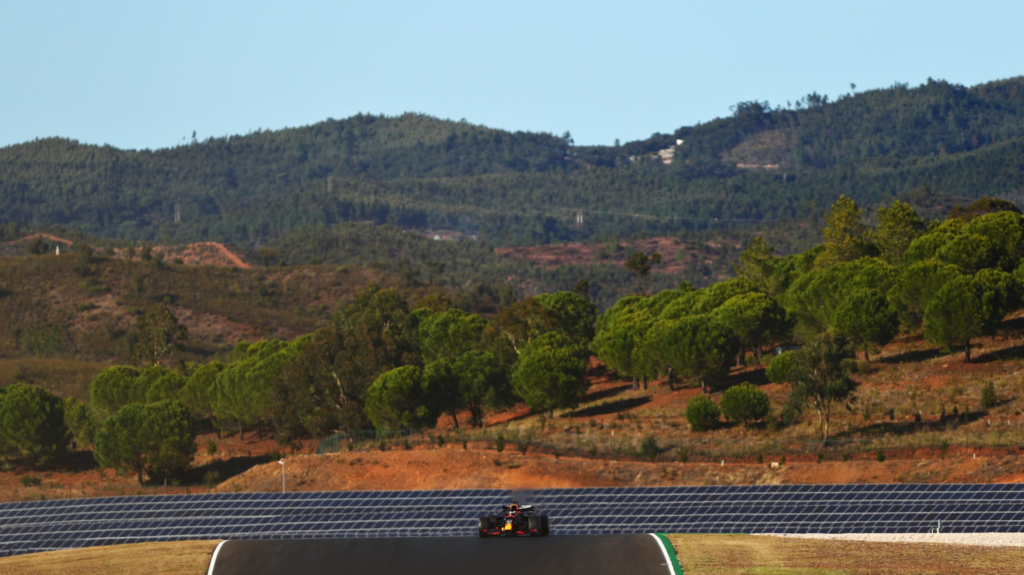Formula 1 is perhaps the most globally coveted racing event ever held. Each race garners hundreds of thousands of viewers and fans, all gathered to spectate an unrivaled competition on the track.
But this popularity isn’t all positive. After decades of races and championships, scientists are starting to piece together how damaging Formula 1 is to the environment and how it could become a key turning point in addressing climate change.

Where does climate change fit into the world’s biggest racing event? With the excessive use of motor engines and cross country traveling, F1’s surface-level impacts appear obvious. Although the regulating organization of Formula 1, Federation Internationale de l’Automobile, has released a plan to tackle this issue, environmentally conscious fans are wondering: Is it enough?
Formula 1 has been held since the 1950’s, and is one of the largest speculated events in the world. One racing season consists of 23 races, each referred to as a Grand Prix, which take place on built circuits or closed public roads depending on the location. Each race is held during a single weekend, with practice on Fridays, qualifying for race day on Saturdays, and the Grand Prix on Sunday. The world’s best race car drivers travel from country to country to compete and earn points for their team. With renowned motor manufacturers like Ferrari, Mercedes, and Renault competing at every track, this racing event can be enjoyed by any sports fan with a need for high speeds.
But with all of this country hopping, Formula 1 almost seems like a band on tour. Stops are made in a variety of countries, from England and Italy to Bahrain and Portugal. The United States has been on the tour list for decades; Indianapolis, Detroit, Long Beach, and most recently Austin, Texas are just a few of the locations. While hosting a Grand Prix is an honor, it seems short-lived — after all, races are held for only a single weekend in each country.
With such a short time to enjoy the event, how well prepared the locations are to host a field of 20 roaring engines, should be discussed. One aspect host locations must consider is the local impact these races have. Formula 1 draws thousands of dedicated fans, many of whom travel to each event to marvel at the sights of these machines and what they are able to accomplish. This tourism contributes to local economies and showcases unique aspects of the host city.
The future of motorsports
The FIA, Federation Internationale de l’Automobile, oversees almost all motorsport events, including Formula 1. The FIA has been pressed to address major issues within Formula 1, among them its environmental impact and contribution to climate change. Recently the FIA released their 10-year environmental strategy in response.

Depicted in this strategy are the goals that the FIA want to achieve, including 2021 carbon neutrality and 2030 net-zero carbon. These goals outline major landmarks on the roadmap for the FIA — but they are not universally applied. Instead, goals for host circuits, racing teams, and sponsors are separate and considered in the “Championships” category of the strategy.
Among these differences is the timeline for action. Circuits and teams are expected to be carbon neutral by 2030, while the FIA plans to do so nine years before then. Why the near 10 year difference? With plentiful resources and examples of ways to host a carbon neutral sporting event, it doesn’t make sense that the FIA does not require this at the same time they go through the transition.
The FIA 2019 Environmental Strategy Report revealed that the organization emitted a whoppingg 18,500 tons of CO2, with over 90% coming from business travel and freight transport. Formula 1 falls under similar pretense, with most of their emissions resulting from transportation — not the racing itself. However, it is safe to say there are still emissions and negative externalities, such as air pollution, associated with the racing.
The environmental impact of Formula 1 can be analyzed on a seasonal basis or through individual races. When looking at specific races it is easier to detect any sustainable practices put into place or if things are continuing business as usual. Jean Todt, President of Formula 1, stated that they face two major risks in the sport: Major accidents, like Romain Grosjean’s horrific crash in Bahrain last year, and their increasing environmental impact. Some teams and drivers have even predicted Formula 1 going extinct as environmentally conscious races like electric powered Formula E, which have a much lower carbon footprint, take the wheel.
In the lead, by example
A newer race track, or circuit, located in Portimão, Portugal exemplifies sustainable racing. The Algarve International Circuit, built in 2008, is only in its second year of hosting a Formula 1 Grand Prix.
The circuit is dubbed The Rollercoaster because of the dips and elevation changes throughout the track. Situated next to the Portuguese coast, high coastal winds can make it more difficult to drive.

With five solar power plants spread across nearly 22 square miles, this host track is raising the bar for sustainability in Formula 1. The solar plants generate enough energy (5.7 megawatts) to power up to 2,500 apartments and prevent over 5,100 tons of CO2 from being emitted. Additionally, small details, such as the military flyover, are being responsibly offset and rainwater is being recycled for irrigation use. This ambitious track should be a model for all new and existing Grand Prix circuits to expand upon.
Important drivers of climate action in motorsports are quite literally the most talented drivers in the world: The racers themselves. Along with having a global reputation, Formula 1 drivers are some of the most daring athletes on the planet.
Lewis Hamilton: “Being a part of the issue is not meaningful.”
We have recently seen host racetracks and even Formula 1 drivers bring light to climate change, pushing it to the forefront of racing discussions.
No Formula 1 article is complete without the mention of Lewis Hamilton. Hamilton, a Formula 1 driver for Mercedes AMG, has always been very outspoken on environmental issues. In an interview with ESPN, the Mercedes driver claimed that Formula 1 was not doing enough to address climate change and the impact the sport is having.
“F1 is only implementing carbon neutral status in 10 years’ time and I don’t fully understand why that doesn’t change sooner. These large corporations that have a lot of money and power behind them and can definitely make change happen quicker, but it’s not their number one priority.” – Lewis Hamilton via ESPN

Hamilton, perhaps the most talented motorsports driver this generation has seen after achieving his 97th career victory, is aspiring to use his voice to change the norms of the sport. He’s working with his Mercedes AMG team to achieve climate neutrality and be an example of sustainable innovation.
Hamilton is known as a pusher, on and off the track. He recently posted a photo of his new electric Mercedes on his Instagram with a lengthy caption depicting how he is changing his everyday habits to be more mindful of the environment. Hamilton has even offset his emissions from his travel in Formula 1, dating back to 2007. It’s also well known that Hamilton has primarily been eating plant-based foods and has attributed a boost in his athletic performance to his more environmentally conscious diet.
Hamilton has also invested in Forest Green Rovers, the world’s first vegan football club. The club’s owner, green energy industrialist Dale Vince, is glad to have Hamilton on board.
In an interview with Mercedes, Hamilton stated that while most of his current legacy is race-centered, he is serious about expanding his impact beyond the race track: “My goal is to help change an industry to accept diversity and to be forward-thinking, and to move towards a greener outlook.”
If any athlete or individual can learn something from Hamilton, it is effort. Putting forth the effort to learn and educate yourself, taking a step back and looking at the bigger picture. Hamilton understands the importance of this and there is no doubt why he has been the face of Formula 1 when it comes to advocating for change.
Vettel and New Sponsorships
Sponsorships are a crucial part of sports, and Formula 1 is no exception. Amidst the oil and gas sponsorships that have so heavily defined Formula 1, there lies a newer sponsorship with the Aston Martin racing team. Better Water Technology (BWT) is a Europe-based water company striving to achieve sustainably treated tap water, countering the excessive use of bottled waters. BWT has been a sponsor in F1 since 2017.

Image Credit: Aston Martin F1
Teammate and previous four-time world champion, Sebastian Vettel, has adorned the pink BWT logo on his helmet with the saying “Change the world, sip by sip.” The German race car driver stated that he was glad to partner with BWT, whose goals align with his own. He believes speaking up as a Formula 1 driver is crucial, and spreading BWT’s massage can reduce the amount of plastic people use.
“The future is important and we must do our best to protect the planet for children and young people. We all share this responsibility and if we come together we can make a difference.”
With drivers stepping up to address environmental concerns, it opens the door for Formula 1 and the host circuits to implement serious changes.
Miami: The newest circuit, coming 2022
Miami, Florida has the honor of being the newest circuit joining the 2022 Formula 1 race calendar. Among the excitement of the race now taking place in South Florida, many groups are curious how Miami’s 10-year contract with F1 will play out. Among these groups are environmentally conscious individuals locally, and abroad.
Miami, known for its towering palm trees and eclectic culture, is one of the most at-risk cities in the world to the effects of climate change. As sea levels rise, flooding threatens many coastal cities with low elevations. Miami sits at just 6 feet above sea level, rendering it extremely vulnerable.

A study aimed at analyzing future flood losses in major coastal cities ranked Miami 2nd in risk on a global scale. The study points out that three American cities, Miami, New York City and New Orleans, equate to 31% of the world’s aggregate losses in the 136 cities studied. With low protection levels, these cities are looking at losses in excess of US $100 Million.
Miami alone is poised to lose over US$366 billion in the next 100 years if we do not take environmental action.
With such an immense risk ahead, what gravitates Miami to host a sporting event idealized on motor engines and sponsored by oil companies?
Stefano Domenicali, The Formula 1 President and CEO, announced that they will be “working closely with the Miami Gardens team from the Hard Rock Stadium and the FIA to ensure the circuit delivers exciting racing but also leaves a positive and lasting contribution to the people in the local community.“
But what is that “lasting contribution”? Now that the location has been chosen, the city of Miami and the Hard Rock Stadium group, where the track will be located, have an immense opportunity this upcoming year. With environmental concerns growing, many citizens of Miami-Dade County would be upset if city officials and Formula 1 chose not to prioritize sustainability
In the words of Lewis Hamilton, “why not now?”
Hamilton’s statement claiming that a decade is too long to wait for climate action shines through with Miami being the newest host of Formula 1. With no time to waste, Miami officials must prioritize environmental concerns as they prepare for the race in 2022.
Starting from scratch provides many opportunities to revolutionize the status quo in motorsports. Using clean renewable energy and implementing sustainable practices — composting, zero waste, responsible water consumption and travel habits, low carbon meals — is just the start. Miami has the power to redefine how Formula 1 is presented. All eyes will be on South Florida next year as it becomes the newest track in Formula 1.
Closing Lap
Miami’s opportunity to make a statement on climate change begs the question of exactly how involved they will be. Can the Miami Grand Prix champion the first-ever zero net carbon Formula 1 race? Could we see huge strides in sustainability? Will Miami officials fail their citizens and not address the climate issue that threatens their city so desperately?
The fact is the world needs change, and the earth needs everyone to do something about it. In a time where climate change has become a main talking point, we should look to see the marriage of these concerns and what actions are taken in beautiful Miami, Florida. To sustain a future for the next generation of sports fans, we need to ensure climate action becomes our champion. If only climate change could garner the podiums like Sir Lewis Hamilton.
Motorsport fans, drivers, host circuits, and individuals of the world have the opportunity to take action today. The Global Climate Pledge is working tirelessly to spread the word and importance of climate awareness. We have adapted a Reaching Out Fan Toolkit for you to communicate with your favorite sports team on these issues. Come together with global athletes, teams, and fans to sign the Global Climate Pledge and join the world’s largest advocacy for a better future.
Written By: Austin Anahory, Sports Sustainability and Engagement Specialist





